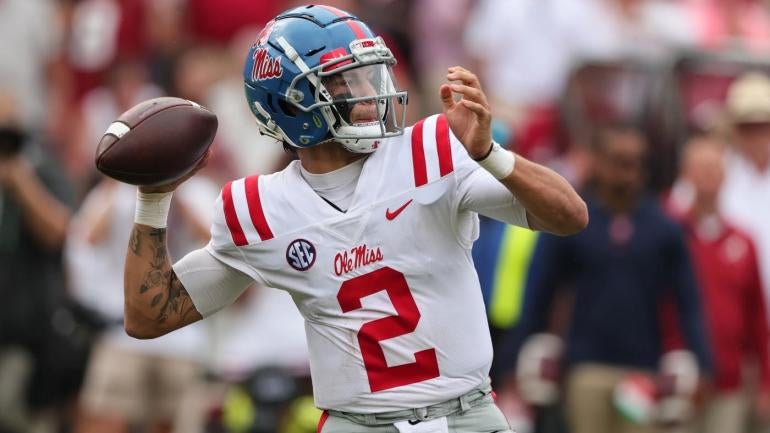
Here's something you've likely heard a lot in recent months: This quarterback class is weak. There is no Trevor Lawrence or Joe Burrow or Kyler Murray. In fact, looking back at the last two classes, it's fair to say that every first-rounder -- Zach Wilson, Trey Lance, Justin Fields, Mac Jones, Tua Tagovailoa, Justin Herbert, Jordan Love -- all would be drafted ahead of this group. That also holds for Davis Mills, a 2021 third-rounder who, had he returned to Stanford last fall, likely would be QB1 as we sit here.
But we're not here to bury this 2022 quarterback class. Instead, we're here to make our case for Ole Miss' Matt Corral as the top draft-eligible passer. (Over the past week, we have made similar cases for Liberty's Malik Willis (read here), Pittsburgh's Kenny Pickett (read here) and Cincinnati's Desmond Ridder (read here).)
Plus, even if this group doesn't measure up against recent QBs, that doesn't mean a) there isn't still a huge need for quarterbacks at the next level and b) those QB-needy teams won't use the time between the combine and the actual draft into actually talking themselves into over-drafting the position because an NFL team without a franchise passer is an NFL team that has no chance to win the Super Bowl.
Corral, who is our QB1, started 23 games his last two seasons at Ole Miss and made huge strides over that span. He finished 2020 completing 71% of his passes for 3,337 yards, 29 touchdowns and 14 interceptions. He also rushed for 506 yards (4.5 yards per carry) and four more touchdowns.
In 2021, Corral's completion percentage (68%) and touchdowns passes (20) dipped slightly, but his interceptions fell to just five. He also rushed for 614 yards (4.0 yards per carry) and 11 rushing touchdowns.
So why the drastic reduction in turnovers last season?
"It's just understanding the drop-eight defensive scheme," Corral told us back in January during an episode of the Pick Six Podcast. "I really didn't understand it at all. I'd never seen it before until Arkansas did it to me. And then after Arkansas did it to me, it was everybody trying to get into the drop eight."
Corral's referring to that Arkansas game from Oct. 17, 2020. The one where he threw six interceptions in a loss to the Razorbacks. After the game he just said, "I gotta get back to work, do what I did to get here. Gotta watch more film. I obviously wasn't watching enough."
It wasn't just watching film but understanding what defenses were trying to do. Corral learned that lesson quickly and adjusted.
"You have 11 sets of eyes watching you (on defense)," Corral told us. "I was trying to find holes in the defense, in the hook zone (area), and I couldn't do it because I was trying to look (defenders) off. ... And it was just frustrating because I didn't understand it. It just was finding the right concepts to play against (drop eight), just going out there and executing and not overthinking it because it's not that complicated."
Corral expounded on that real-time learning experience when we spoke again at the combine, and he admitted that his overaggressiveness played a big role in those struggles. As soon as the ball was snapped, the defense would drop everyone into coverage because "they knew that we just wanted to take shots and I kind of took that too far."
But once Corral dialed back the aggressiveness, good things started to happen for him and the offense.
"Understanding the defense and knowing that what they're trying to accomplish with drop eight and just taking what they give us, the big plays are going come to you, you don't need to force it," he said. "And then once you take what they give you, they're going to be trigger happy on the short routes. And when they start doing that, you take the shots (down the field)."
So how did this newfound understanding manifest itself last fall? First, here's our scouting report on the Ole Miss quarterback:
- Corral is good in space, runs Lane Kiffin's RPO at a high level, and has the speed and athleticism to turn the corner and outrun linebackers downfield. He has a strong arm but needs to work on layering throws to the second and third levels with more consistency. Corral shows high-level accuracy on short and intermediate throws, but his deep-ball accuracy can be hit or miss. He also struggles with pressure and needs to be more consistent with off-platform throws.
And here are a handful of plays that will get the fan base of any QB-needy team excited about the potential possibilities.
There's the accuracy and ball placement on tight-window back-shoulder throws...
Still thinking about this throw and catch from Monday night. #OleMiss
— Dane Brugler (@dpbrugler) September 9, 2021
The confidence and arm talent from QB Matt Corral. 📈
The hands and focus from WR Dontario Drummond. 📈 pic.twitter.com/HzWDV8OL27
And the ability to spin it without stepping into the throw...
This throw is silly from Matt Corral.
— Nick Penticoff (@NickPenticoff) March 8, 2022
Look at where his body is facing and where the ball goes.
pic.twitter.com/35IMV5YYP5
The touch on deep throws...
Hahahaha this throw by Matt Corral is bonkers
— Pickswise (@Pickswise) October 9, 2021
(via @espn) pic.twitter.com/nVXOh88aOj
The ability to move inside the pocket, keep his eyes downfield, and deliver a dime...
This angle makes it look more impressive pic.twitter.com/P2IC7eHSXA
— Goal Line Stand (@GoalLineStand2) April 3, 2022
The capacity to run with elusiveness and toughness...
Thinking about this Matt Corral run 🥲✌️ pic.twitter.com/RIzwpj76JA
— Grayson Weir (@GsonJW) January 3, 2022
And the playmaking in the RPO offense...
Matt Corral with another great rep off the RPO.
— WBG84 (@WBG84) December 15, 2021
Once the SAM LB commits to the run, Corral pulls the ball and delivers a quick strike in a tight window, which leads to a big play after the catch by the receiver. #NFLDraft pic.twitter.com/Z6PumVvliR
It's that last clip that has some people concerned. How does Lane Kiffin's RPO offense at Ole Miss translate to the NFL? CBS Sports' Emory Hunt asked Corral exactly this at the combine and here's what the quarterback said.
It's not all perfect, and it's important to remember that these clips are highlights, not the totality of Corral's game. As we mentioned in the scouting report above, he needs to be more consistent on deep throws, and he can leave the pocket too early at times. He'll also miss throws that are considered routine in the NFL. And perhaps most important, he's only 6-foot-1. He weighed 215 pounds at the combine but appeared to play below that weight last season, and at that size, his style of play may not be sustainable at the next level unless he can take a few hits.
According to ESPN, Corral is scheduled to visit five teams ahead of the draft, which starts April 28. Those teams include the Panthers, Eagles, Steelers, Saints and Falcons. All teams with varying needs at the quarterback position, all teams with first-round picks -- and in the case of Philly and New Orleans, two first-rounders.
The first question is would the Panthers take Corral at No. 6? They shouldn't because that team desperately needs to fix its offensive line. Unfortunately, they don't pick again until the fourth round, so they'd have to either trade down in the first round or give up future picks -- or current players -- to get back in the mix for Corral. The Eagles seem committed to Jalen Hurts, but they also seemed committed to Carson Wentz when they drafted Hurts in the second round back in 2020.
The Steelers signed Mitch Trubisky to a two-year deal, and he feels like a good fit for Matt Canada's offense, but so does Corral, who still has all the upside of what could be. And the Saints have Jameis Winston on a two-year contract, and he appears to be the unquestioned starter, but he's coming off an ACL injury. And more than that, if Sean Payton really liked the prospect of Taysom Hill under center, new coach Dennis Allen, in what should be a similar-looking offense, should really love Corral. (Of course, this assumes that there were coaches other than Payton who bought into the Hill experiment).
So, yeah, Corral is an imperfect quarterback prospect, but he's not alone. And in this class, he remains our favorite because he offers the best mix of upside and NFL readiness. Willis has the most upside of the group, but there are even more questions about how his game might translate to the NFL. And Pickett has the most experience but feels closer to his ceiling than Corral, Willis, Ridder and North Carolina's Sam Howell.
We say it all the time and it's worth repeating here: the draft is more art than science, and three years from now who knows how this class will turn out. In 2017, Trubisky went ahead of Patrick Mahomes and Deshaun Watson. The next year, Baker Mayfield and Sam Darnold went before Josh Allen. Maybe Corral lasts until the second round. And maybe Corral ends up as the best passer in this class. Both seem eminently possible just two weeks out from the actual draft.





















